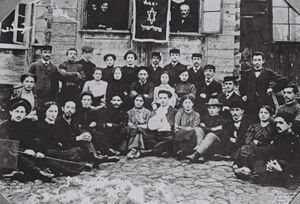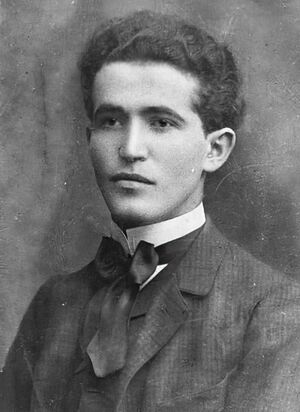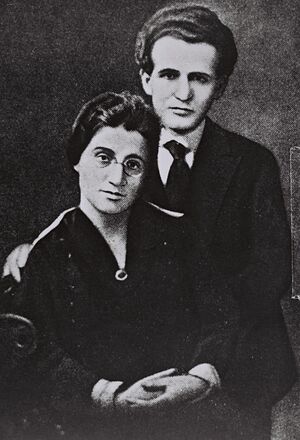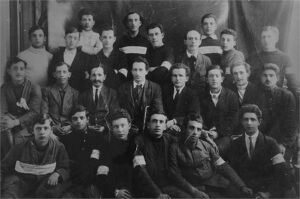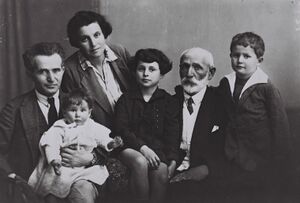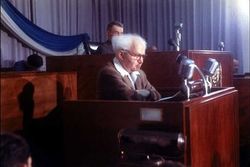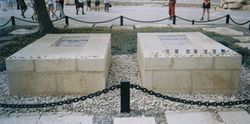داڤيد بن گوريون
داڤيد بن گوريون | |
|---|---|
דָּוִד בֶּן־גּוּרִיּוֹן | |
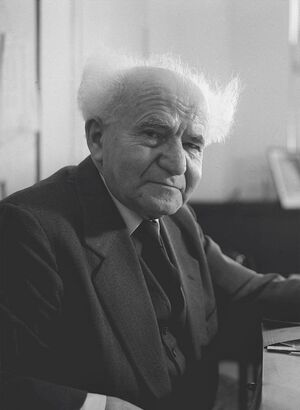 بن جوريون في 1960 | |
| رئيس وزراء إسرائيل الأول | |
| في المنصب 3 November 1955 – 26 يونيو 1963 | |
| الرئيس | |
| سبقه | موشيه شاريت |
| خلـَفه | Levi Eshkol |
| في المنصب 17 May 1948 – 7 December 1953 | |
| الرئيس |
|
| سبقه | New office |
| خلـَفه | Moshe Sharett |
| Chairman of the Provisional State Council of Israel | |
| في المنصب 14 May 1948 – 16 May 1948 | |
| سبقه | New office |
| خلـَفه | Chaim Weizmann |
| Minister of Defense | |
| في المنصب 21 February 1955 – 26 June 1963 | |
| رئيس الوزراء |
|
| سبقه | Pinhas Lavon |
| خلـَفه | Levi Eshkol |
| في المنصب 14 May 1948 – 26 January 1954 | |
| رئيس الوزراء | Himself |
| سبقه | New office |
| خلـَفه | Pinhas Lavon |
| تفاصيل شخصية | |
| وُلِد | David Grün 16 أكتوبر 1886 Płońsk, Congress Poland, Russian Empire |
| توفي | 1 ديسمبر 1973 (aged 87) رامات گان، إسرائيل |
| الجنسية | |
| الحزب | |
| الزوج | |
| الأنجال | 3 |
| المدرسة الأم | جامعة اسطنبول |
| التوقيع | |
داڤيد بن گوريون ( David Ben-Gurion ؛ /bɛn ˈɡʊəriən/ ben GOOR-ee-ən؛ بالعبرية: דָּוִד בֶּן־גּוּרִיּוֹן [daˈvid ben ɡuʁˈjon] (![]() استمع); وُلِد بإسم داڤيد گرون David Grün؛ 16 اكتوبر 1886 إلى 1 ديسمبر 1973). المؤسس القومي لدولة إسرائيل وكذلك أوّل رئيس وزراء إسرائيل. As head of the Jewish Agency from 1935, and later president of the Jewish Agency Executive, he was the de facto leader of the Jewish community in Palestine, and largely led the movement for an independent Jewish state in Mandatory Palestine.
استمع); وُلِد بإسم داڤيد گرون David Grün؛ 16 اكتوبر 1886 إلى 1 ديسمبر 1973). المؤسس القومي لدولة إسرائيل وكذلك أوّل رئيس وزراء إسرائيل. As head of the Jewish Agency from 1935, and later president of the Jewish Agency Executive, he was the de facto leader of the Jewish community in Palestine, and largely led the movement for an independent Jewish state in Mandatory Palestine.
Born in Płońsk, then part of Congress Poland, to Polish Jewish parents, he immigrated to the Palestine region of the Ottoman Empire in 1906. Adopting the name of Ben-Gurion in 1909, he rose to become the preeminent leader of the Jewish community in British-ruled Mandatory Palestine from 1935 until the establishment of the State of Israel in 1948, which he led until 1963 with a short break in 1954–55. Ben-Gurion's interest for Zionism developed early in his life, leading him to become a major Zionist leader, and the executive head of the World Zionist Organization in 1946.[1]
On 14 May 1948, he formally proclaimed the establishment of Israel, and was the first to sign the Israeli Declaration of Independence, which he had helped to write. Under Ben-Gurion's leadership, the 1948 Arab–Israeli War saw the uniting of the various Jewish militias into the Israel Defense Forces (IDF), and the expulsion and flight of a majority of the Palestinian Arab population. Subsequently, he became known as "Israel's founding father".[2] Following the war, Ben-Gurion served as Israel's first prime minister and minister of defence. As prime minister, he helped build state institutions, presiding over national projects aimed at the development of the country. He also oversaw the absorption of Jewish immigrants. A major part of his foreign policy was improving relations with West Germany through a reparations agreement in compensation for Nazi confiscation of Jewish property during the Holocaust.[3]
In 1954, he resigned as prime minister and minister of defence but remained a member of the Knesset. He returned as minister of defence in 1955 after the Lavon Affair and the resignation of Pinhas Lavon. Later that year he became prime minister again, following the 1955 elections. He led Israel's reprisal operations to Arab guerrilla attacks, and its invasion of Egypt along with Britain and France during the Suez Crisis in 1956. He stepped down from office in 1963, and retired from political life in 1970. He then moved to his modest "hut" in Sde Boker, a kibbutz in the Negev desert, where he lived until his death. Posthumously, Ben-Gurion was named one of Time magazine's 100 Most Important People of the 20th century.
النشأة

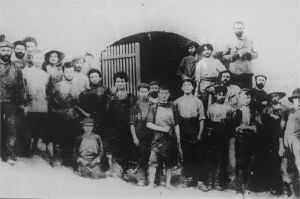
Childhood and education
David Ben-Gurion was born in Płońsk in Congress Poland—then part of the Russian Empire, to Polish Jewish parents. His father, Avigdor Grün, was a pokątny doradca (secret adviser), navigating his clients through the often corrupt Imperial legal system.[4] Following the publication of Theodore Herzl's Der Judenstaat in 1896 Avigdor co-founded a Zionist group called Beni Zion—Children of Zion. In 1900 it had a membership of 200.[5] David was the youngest of three boys with an older and younger sister. His mother, Scheindel (Broitman),[6] died of sepsis following a stillbirth in 1897. It was her eleventh pregnancy.[7] Two years later his father remarried.[8] Ben-Gurion's birth certificate, found in Poland in 2003, indicated that he had a twin brother who died shortly after birth.[9] Between the ages of five and 13 Ben-Gurion attended five different heders as well as compulsory Russian classes. Two of the heders were 'modern' and taught in Hebrew rather than Yiddish. His father could not afford to enroll Ben-Gurion in Płońsk's beth midrash so Ben-Gurion's formal education ended after his bar mitzvah.[10] At the age of 14 he and two friends formed a youth club, Ezra, promoting Hebrew studies and emigration to the Holy Land. The group ran Hebrew classes for local youth and in 1903 collected funds for the victims of the Kishinev pogrom. One biographer writes that Ezra had 150 members within a year.[11] A different source estimates the group never had more than "several dozen" members.[12]
In 1904 Ben-Gurion moved to Warsaw where he hoped to enroll in the Warsaw Mechanical-Technical School founded by Hipolit Wawelberg. He did not have sufficient qualifications to matriculate and took work teaching Hebrew in a Warsaw heder. Inspired by Tolstoy he had become a vegetarian.[11] He became involved in Zionist politics and in October 1905 he joined the clandestine Social-Democratic Jewish Workers' Party—Poalei Zion. Two months later he was the delegate from Płońsk at a local conference.[13] While in Warsaw the Russian Revolution of 1905 broke out and he was in the city during the clamp down that followed; he was arrested twice, the second time he was held for two weeks and only released with the help of his father. In December 1905 he returned to Płońsk as a full-time Poalei Zion operative. There he worked to oppose the anti-Zionist Bund who were trying to establish a base. He also organised a strike over working conditions amongst garment workers. He was known to use intimidatory tactics, such as extorting money from wealthy Jews at gunpoint to raise funds for Jewish workers.[14][15][16]
Ben-Gurion discussed his hometown in his memoirs, saying:
For many of us, anti-Semitic feeling had little to do with our dedication [to Zionism]. I personally never suffered anti-Semitic persecution. Płońsk was remarkably free of it ... Nevertheless, and I think this very significant, it was Płońsk that sent the highest proportion of Jews to Eretz Israel from any town in Poland of comparable size. We emigrated not for negative reasons of escape but for the positive purpose of rebuilding a homeland ... Life in Płońsk was peaceful enough. There were three main communities: Russians, Jews and Poles. ... The number of Jews and Poles in the city were roughly equal, about five thousand each. The Jews, however, formed a compact, centralized group occupying the innermost districts whilst the Poles were more scattered, living in outlying areas and shading off into the peasantry. Consequently, when a gang of Jewish boys met a Polish gang the latter would almost inevitably represent a single suburb and thus be poorer in fighting potential than the Jews who even if their numbers were initially fewer could quickly call on reinforcements from the entire quarter. Far from being afraid of them, they were rather afraid of us. In general, however, relations were amicable, though distant.[17]
In autumn of 1906 he left Poland to go to Palestine. He travelled with his sweetheart Rachel Nelkin and her mother, as well as Shlomo Zemach his comrade from Ezra. His voyage was funded by his father.[18]
Ottoman Empire and Constantinople
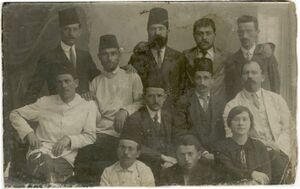
Immediately on landing in Jaffa, 7 September 1906, Ben-Gurion set off, on foot, in a group of 14, to Petah Tikva.[19][20] It was the largest of the 13 Jewish agricultural settlements and consisted of 80 households with a population of nearly 1,500; of these around 200 were Second Aliyah pioneers like Ben-Gurion. He found work as a day labourer, waiting each morning hoping to be chosen by an overseer. Jewish workers found it difficult competing with local villagers who were more skilled and prepared to work for less. Ben-Gurion was shocked at the number of Arabs employed. In November he caught malaria and the doctor advised he return to Europe. By the time he left Petah Tikva in summer of 1907 he had worked an average 10 days a month which frequently left him with no money for food.[21][22] He wrote long letters in Hebrew to his father and friends. They rarely revealed how difficult life was. Others who had come from Płońsk were writing about tuberculosis, cholera and people dying of hunger.[23]
On his disembarkation at Jaffa, Ben-Gurion had been spotted by Israel Shochat who had arrived two years previously and had established a group of around 25 Poale Zion followers. Shochat made a point of inspecting new arrivals looking for recruits. A month after his arrival at Petah Tikva, Shochat invited Ben-Gurion to attend the founding conference of the Jewish Social Democratic Workers' Party in the Land of Israel in Jaffa. The conference, 4–6 October 1906, was attended by 60 or so people. Shochat engineered the elections so that Ben-Gurion was elected onto the five-man Central Committee and the 10-man Manifesto Committee. He also arranged that Ben-Gurion was chosen as chairman of the sessions. These Ben-Gurion conducted in Hebrew, forbidding the translation of his address into Russian or Yiddish. The conference was divided: a large faction—Rostovians—wanted to create a single Arab–Jewish proletariat. This Shochat and Ben-Gurion opposed. The conference delegated the Manifesto Committee the task of deciding the new party's objectives. They produced The Ramleh Program which was approved by a second smaller 15-man conference held in Jaffa the following January 1907. The program stated "the party aspires to political independence[24] of the Jewish People in this country." All activities were to be conducted in Hebrew; there should be segregation of the Jewish and the Arab economies; and a Jewish trade union was to be established. Three members of the Central Committee resigned and Ben-Gurion and Shochat continued meeting weekly in Jaffa or Ben Shemen where Shochat was working. Ben-Gurion walked to the meetings from Petah Tikva until he moved to Jaffa where he gave occasional Hebrew lessons. His political activity resulted in the establishment of three small trade unions amongst some tailors, carpenters and shoemakers. He set up the Jaffa Professional Trade Union Alliance with 75 members. He and Shochat also brokered a settlement to a strike at the Rishon Le Zion winery where six workers had been sacked. After three months the two-man Central Committee was dissolved, partly because, at that time, Ben-Gurion was less militant than Shochat and the Rostovians. Ben-Gurion returned to Petah Tikva.[25][26][27][28]
During this time Ben-Gurion sent a letter to Yiddish Kemfer ("The Jewish Fighter"), a Yiddish newspaper in New York City. It was an appeal for funds and was the first time something written by Ben-Gurion was published.[29]
The arrival of Yitzhak Ben-Zvi in April 1907 revitalised the local Poale Zion. Eighty followers attended a conference in May at which Ben-Zvi was elected onto a two-man Central Committee and all Ben-Gurion's policies were reversed: Yiddish, not Hebrew, was the language to be used; the future lay with a united Jewish and Arab proletariat. Further disappointment came when Ben-Zvi and Shochat were elected as representatives to go to the World Zionist Congress. Ben-Gurion came last of five candidates. He was not aware that at the next gathering, on Ben-Zvi's return, a secret para-military group was set up—Bar-Giora—under Shochat's leadership. Distancing himself from Poale Zion activism Ben-Gurion, who had been a day-labourer at Kfar Saba, moved to Rishon Lezion where he remained for two months. He made detailed plans with which he tried to entice his father to come and be a farmer.[30]
In October 1907, on Shlomo Zemach's suggestion, Ben-Gurion moved to Sejera. An agricultural training farm had been established at Sejera in the 1880s and since then a number of family-owned farms, moshavah, had been established forming a community of around 200 Jews. It was one of the most remote colonies in the foothills of north-eastern Galilee. It took the two young men three days to walk there.[31] Coincidentally at the same time Bar Giora, now with about 20 members and calling themselves 'the collective' but still led by Shochat, took on the operating of the training farm. Ben-Gurion found work in the farm but, excluded from 'the collective', he later became a labourer for one of the moshav families. One of the first acts of 'the collective' was organising sacking of the farm's Circassian nightwatchman. As a result, shots were fired at the farms every night for several months. Guns were brought and the workforce armed. Ben-Gurion took turns patrolling the farm at night.[32]
In the autumn of 1908 Ben-Gurion returned to Plonsk to be conscripted into the army and avoid his father facing a heavy fine. He immediately deserted and returned to Sejera, travelling, via Germany, with forged papers.[33]
On 12 April 1909 two Jews from Sejera were killed in clashes with local Arabs following the death of a villager from Kfar Kanna, shot in an attempted robbery. There is little conformation of Ben-Gurion's accounts of his part in this event.[34]
Later that summer, Ben-Gurion moved to Zichron Yaakov. From where the following spring he was invited, by Ben-Zvi, to join the staff of Poale Zion's new Hebrew periodical, Ha'ahdut (The Unity), which was being established in Jerusalem.[35] They needed his fluency in Hebrew for translating and proof reading.[36] It was the end of his career as a farm labourer. The first three editions came out monthly with an initial run of 1000 copies. It then became a weekly with a print run of 450 copies.[37][36] He contributed 15 articles over the first year, using various pen names, eventually settling for Ben Gurion.[38] The adopting of Hebrew names was common amongst those who remained during the Second Aliyah. He chose Ben-Gurion after the historic Joseph ben Gurion.[39]
In the spring of 1911, faced with the collapse of the Second Aliyah, Poale Zion's leadership decided the future lay in "Ottomanisation". Ben-Zvi, Manya and Israel Shochat announced their intention to move to Istanbul. Ben-Zvi and Shochat planned to study law; Ben-Gurion was to join them but first needed to learn Turkish, spending eight months in Salonika, at that time the most advanced Jewish community in the area. Whilst studying he had to conceal that he was Ashkenazi due to local Sephardic prejudices. Ben-Zvi obtained a forged secondary school certificate so Ben-Gurion could join him in Istanbul University. Ben-Gurion was entirely dependent on funding from his father, while Ben-Zvi found work teaching. Struggling with ill health, Ben-Gurion spent some time in hospital.[40][41]
Ben-Gurion in America, 1915–1918
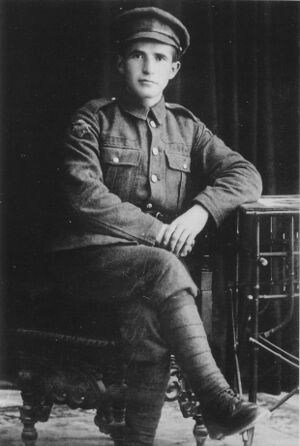
Ben-Gurion was at sea, returning from Istanbul, when the First World War broke out. He was not amongst the thousands of foreign nationals deported in December 1914.[42] Based in Jerusalem, he and Ben-Zvi recruited forty Jews into a Jewish militia to assist the Ottoman Army. Despite his pro-Ottoman declarations he was deported to Egypt in March 1915.[43] From there he made his way to the United States, arriving in May. For the next four months Ben-Gurion and Ben Zvi embarked on a speaking tour planned to visit Poale Zion groups in 35 cities in an attempt to raise a pioneer army, Hechalutz, of 10,000 men to fight on the Ottoman side.[44] The tour was a disappointment. Audiences were small; Poale Zion had fewer than 3,000 members, mostly in the New York area. Ben-Gurion was hospitalised with diphtheria for two weeks and spoke on only five occasions and was poorly received. Ben-Zvi spoke to 14 groups as well as an event in New York City and succeeded in recruiting 44 volunteers for Hechalutz; Ben-Gurion recruited 19.[45] Ben-Gurion embarked on a second tour in December, speaking at 19 meetings, mostly in small towns with larger events in Minneapolis and Galveston.[46] Due to the lack of awareness of Poale Zion's activities in Palestine it was decided to republish Yizkor in Yiddish. The Hebrew original was published in Jaffa in 1911; it consisted of eulogies to Zionist martyrs and included an account by Ben-Gurion of his Petah Tikva and Sejera experiences. The first edition appeared in February 1916 and was an immediate success; all 3,500 copies were sold. A second edition of 16,000 was published in August. Martin Buber wrote the introduction to the 1918 German edition. The follow-up was conceived as an anthology of work from Poale Zion leaders; in fact Ben-Gurion took over as editor, writing the introduction and two-thirds of the text. He suspended all his Poale Zion activities and spent most of the next 18 months in New York Public Library. Ben-Zvi, originally designated as co-editor, contributed a section on Jewish history in which he expounded the theory that the fellahin currently living in the area were descendants of pre-Roman conquest Jews. Eretz Israel – Past and Present was published in April 1918. It cost $2 and was 500 pages long, over twice the length of Yizkor. It was an immediate success, selling 7,000 copies in 4 months; second and third editions were printed. Total sales of 25,000 copies made a profit of $20,000 for Poale Zion. It made Ben-Gurion the most prominent Poale Zion leader in America.[47][48]
In May 1918 Ben-Gurion joined the newly formed Jewish Legion of the British Army and trained at Fort Edward in Windsor, Nova Scotia. He volunteered for the 38th Battalion, Royal Fusiliers, one of the four which constituted the Jewish Legion. His unit fought against the Ottomans as part of Chaytor's Force during the Palestine Campaign, though he remained in a Cairo hospital with dysentery. In 1918, after a period of guarding prisoners of war in the Egyptian desert, his battalion was transferred to Sarafand. On 13 December 1918 he was demoted from corporal to private, fined three days' pay and transferred to the lowest company in the battalion. He had been five days absent without leave visiting friends in Jaffa. He was demobilised in early 1919.[49]
Marriage and family
One of Ben-Gurion's companions when he made the Aliyah was Rachel Nelkin. Her step-father, Reb Simcha Isaac, was the leading Zionist in Płońsk, and they had met three years previously at one of his meetings. It was expected that their relationship would continue when they landed in Jaffa but he shut her out after she was fired on her first day labouring—manuring the citrus groves of Petah Tikva.[50][51][52]
Whilst in New York City in 1915, he met Russian-born Paula Munweis and they married in 1917. In November 1919, after an 18-month separation, Paula and their daughter Geula joined Ben-Gurion in Jaffa. It was the first time he met his one-year-old daughter.[53] The couple had three children: a son, Amos, and two daughters, Geula Ben-Eliezer and Renana Leshem. Amos married Mary Callow, already pregnant with their first child. She was an Irish gentile, and although Reform rabbi Joachim Prinz converted her to Judaism soon after, neither the Palestine rabbinate nor her mother-in-law Paula Ben-Gurion considered her a real Jew until she underwent an Orthodox conversion many years later.[54][55][56] Amos became Deputy Inspector-General of the Israel Police, and also the director-general of a textile factory. He and Mary had six granddaughters from their two daughters and a son, Alon, who married a Greek gentile.[57][مطلوب مصدر أفضل] Geula had two sons and a daughter, and Renana, who worked as a microbiologist at the Israel Institute for Biological Research, had a son.[58]
Zionist leadership between 1919 and 1948
After the death of theorist Ber Borochov, the left-wing and centrist factions of Poalei Zion split in February 1919, with Ben-Gurion and his friend Berl Katznelson leading the centrist faction of the Labor Zionist movement. The moderate Poalei Zion formed Ahdut HaAvoda with Ben-Gurion as leader in March 1919.
In 1920 he assisted in the formation of the Histadrut, the Zionist Labor Federation in Palestine, and served as its general secretary from 1921 until 1935. At Ahdut HaAvoda's 3rd Congress, held in 1924 at Ein Harod, Shlomo Kaplansky, a veteran leader from Poalei Zion, proposed that the party should support the British Mandatory authorities' plans for setting up an elected legislative council in Palestine. He argued that a Parliament, even with an Arab majority, was the way forward. Ben-Gurion, already emerging as the leader of the Yishuv, succeeded in getting Kaplansky's ideas rejected.[59]
In 1930, Hapoel Hatzair (founded by A. D. Gordon in 1905) and Ahdut HaAvoda joined forces to create Mapai, the more moderate Zionist labour party (it was still a left-wing organisation, but not as far-left as other factions) under Ben-Gurion's leadership. In the 1940s the left-wing of Mapai broke away to form Mapam. Labor Zionism became the dominant tendency in the World Zionist Organization and in 1935 Ben-Gurion became chairman of the executive committee of the Jewish Agency, a role he kept until the creation of the state of Israel in 1948.
During the 1936–1939 Arab revolt in Palestine, Ben-Gurion instigated a policy of restraint ("Havlagah") in which the Haganah and other Jewish groups did not retaliate for Arab attacks against Jewish civilians, concentrating only on self-defense. In 1937, the Peel Commission recommended partitioning Palestine into Jewish and Arab areas and Ben-Gurion supported this policy.[60] This led to conflict with Ze'ev Jabotinsky who opposed partition and as a result Jabotinsky's supporters split with the Haganah and abandoned Havlagah.
The house where he lived from 1931 on, and for part of each year after 1953, is now a historic house museum in Tel Aviv, the "Ben-Gurion House". He also lived in London for some months in 1941.[61]
In 1946, Ben-Gurion and North Vietnam's Politburo chairman Ho Chi Minh became very friendly when they stayed at the same hotel in Paris. Ho Chi Minh offered Ben-Gurion a Jewish home-in-exile in Vietnam. Ben-Gurion declined, telling Ho Chi Minh: "I am certain we shall be able to establish a Jewish Government in Palestine."[62][63]
قيادة الصهيونية
كان بن جوريون من طلائع الحركة العمّالية الصهيونية في مرحلة تأسيس دولة إسرائيل. وخلال فترة رئاسته لمجلس الوزراء الإسرائيلي الممتد من 25 يناير 1948 وحتى 1963 (باستثناء الأعوام 1953 حتى 1955) (1)، فقد قاد بن غوريون إسرائيل في حرب 1948 التي يُطلق عليها الإسرائيليون، حرب الإستقلال. ويعد بن غوريون من المؤسسين لحزب العمل الإسرائيلي والذي تبوّأ رئاسة الوزراء الإسرائيلية لمدة 30 عاماً منذ تأسيس إسرائيل.
في المرحلة السابقة لتأسيس إسرائيل، كان بن جوريون يُوصف بالمعتدل مقارنة بمنظمة الهاجاناه الصهيونية التي تعامل معها البريطانيون في مواقف متعدّدة. ومن جانب آخر، فقد شارك بن غوريون بمظاهر المقاومة المسلحة عندما تعاونت الهاجاناه مع منظمة الإرجون التابعة لمناحيم بيغن. ولكن بعد أسابيع من الإعلان الرسمي لقيام دولة إسرائيل، أمر رئيس الوزراء الجديد (بن جوريون) بحل جميع المنظمات المسلحة كالهاجاناه وشتيرن في سبيل تأسيس جيش الدفاع الإسرائيلي. وبهذه التعديلات الجديدة التي طرأت على التنظيمات المسلحة الصهيونية، أمر بن غوريون بإغراق السفينة "ألتالينا" المحملة بالسلاح، وكان السلاح الذي على متنها سيؤول إلى منظمة الارجون الصهيونية. والى اليوم، يظل الأمر الذي أصدره بن غوريون بإغراق السفينة مثاراً للجدل! وقامت "مجلة تايم" الأمريكية باختياره كأحد أبرز 100 شخصية عالمية شكّلت القرن العشرين.
الحرب البيولوجية
نشرت صحيفة "هآرتس" الإسرائيلية، في تقرير لها، أن رئيس حكومة إسرائيل الأول ديفيد بن غوريون كان قد أمر، خلال معارك النكبة في العام 1948، بتنفيذ عملية سرية لتسميم الآبار في القرى والبلدات الفلسطينية، لمنع عودة أصحاب هذه القرى أو الجيوش العربية إليها، وأنه أوعز بإدارتها لوزير الأمن آنذاك موشيه دايان، وقائد قوات البلماح إيغال ألون، والرئيس الإسرائيلي الرابع إفرايم كاتسير، وأخيه أهرون كاتسير وحملت اسم "أرسل خبزك".
ونُشرت الدراسة المذكورة أخيراً في المجلة العلمية "ميدل إيسترن ستاديز"، وتؤكد استخدام قوات الهاغاناه (البلماح) السلاح البيولوجي خلال حرب النكبة، وفقاً للعملية المذكورة، والتي وضعها بن غوريون، وكان قد لمّح إليها في سجل يومياته في الأول من إبريل، عندما كتب عن "تطور العلم واستخدامه قريباً، ثم إشارته في كتاب يومياته بعد ذلك بشهر إلى شراء مواد بيولوجية بقيمة ألفي دولار.
وتشير الدراسة إلى محاولات بن غوريون تسميم آبار في بلدات ومدن فلسطينية من عكا في أعالي الجليل، وحتى مدينة غزة جنوباً.
وتؤكد الوثائق التي عثر عليها معدا الدراسة في أرشيف جيش الاحتلال أن هذه العملية بدأت قبل شهر ونصف من إعلان بن غوريون إقامة "إسرائيل"، كما تؤكد أنه تم تسميم آبار في عكا، وغزة، وبئر السبع، وأريحا، وقرية عيلبون، في الجليل، وبيدو ووبيت سوريك القريبة من القدس، عبر وضع جراثيم فيها تسبّب مرضَي التيفوس والديزنطاريا. وهي قصة كانت قد ظهرت قبل عدة عقود بالاعتماد على إصابات في عكا، وروايات شفهية لضباط وقادة عسكريين سابقين شاركوا في حرب النكبة.
ووفقاً للدراسة، فقد كانت العملية تشمل أيضاً تسميم آبار المياه في عواصم عربية مثل القاهرة وبيروت، لكن هذا الشق من العملية لم ينفَذ وظل على الورق.
وكانت أول إشارة فعلية لهذه العملية تتعلق بإعدام وقتل اثنين من عملاء عصابات البلماح تسللا وراء خطوط القتال إلى غزة، وحاولا تسميم آبار المياه فيها، وهما عزرا عفجين ودافيد مزراحي. وكان الاثنان ضمن وحدات المستعربين في عصابات البلماح، وغادرا إلى غزة في 22 أغسطس من العام 1948.
ووفقاً لمقطع من أرشيف "هآرتس" يعود لسنوات الأربعين، فقد تم إلقاء القبض على الاثنين وتقديمهما لمحكمة عسكرية مصرية أقرت إعدامهما بعد إدانتهما بمحاولة تسميم آبار المياه في غزة. وادعت إسرائيل يومها أن الاثنين أعدما دون ذنب، وأن الادعاءات المصرية لا تختلف عن الدعاية النازية التي قادها في ألمانيا النازية وزير الإعلام النازي جوزيف غوبلز.
وبحسب الصحيفة، فإن بني موريس عثر على وثائق كثيرة في أرشيف الجيش عن العملية، ولم تكن الرقابة العسكرية قد انتبهت إلى أن الاسم الذي حملته هذه الوثائق، وهو "أرسل خبزك"، يحوي معلومات عن أولى عمليات الحرب البيولوجية التي استخدمتها العصابات الصهيونية خلال حرب النكبة.[64]
السياسة الخارجية
تحالف المحيط
ويقصد بتحالف المحيط استراتيجية في السياسة الخارجية وضعها رئيس الوزراء الإسرائيلي ديفيد بن غوريون، ودعت إسرائيل إلى متابعة علاقات ثنائية وثيقة بشكل استثنائي مع بعض الدول غير العربية في جميع أنحاء الشرق الأوسط وشمال أفريقيا، بهدف إنشاء ثقل سياسي موثوق يناظر التحالفات العسكرية العربية في الصراع العربي الإسرائيلي. وطبقت هذه السياسة بشكل أساسي فيما يتعلق بـتركيا، وإيران، والإمبراطورية الإثيوبية، واتجاه الأكراد الذين يعيشون في العراق وسوريا.[65][66] وجزء من الاستراتيجية، وصل في 28 أغسطس 1958 رئيس الوزراء الإسرائيلي ديفيد بن غوريون إلى أنقرة بزيارة سرية، جرى خلالها التوقيع على اتفاقية سرية في أنطاليا مع رئيس الوزراء التركي عدنان مندريس، وكانت هذه الاتفاقية جزء من تحالف المحيط. وأسست الاتفاقية لعصر من التعاون الأمني غير المسبوق بين البلدين، وفي سعيهما لمواجهة التوسع السوفييتي، والقومية العربية، والإسلاموية، والإرهاب، إذ انخرطت تركيا وإسرائيل في تبادل معلومات استخباراتية رفيعة المستوى والتخطيط للحرب، بما في ذلك عقد اجتماعات نصف سنوية بين قادة الاستخبارات والجيش في كل منهما.
ونصت الاتفاقية على تعزيز التعاون بين البلدين في المجالات التالية:
- الدفاع المشترك
- تبادل المعلومات الاستخبارية
- التدريب العسكري
- التعاون الصناعي
- التعاون الاقتصادي
وفي 1996 دخلت أنقرة بسرعة في عدد من اتفاقيات التعاون الأمني مع إسرائيل والتي تضمنت نقل التكنولوجيا العسكرية، وتبادل المعلومات الاستخباراتية، والتدريب على مكافحة الإرهاب، وذلك بموجب اتفاقية الدفاع التركية الإسرائيلية، والتي دفعت أنقرة إلى شراء عدد كبير من الأسلحة وتحديث التكنولوجيا من الشركات الإسرائيلية، وإنفاق أكثر من 2 مليار دولار خلال العقد اللاحق.[67]
من أقواله
لو كنت زعيما عربيا لن أوقع اتفاقا مع إسرائيل أبدا. إنه أمر طبيعي: لقد أخذنا بلدهم. صحيح أن الله وعدنا به
ولكن في ماذا يمكن أن يهمهم ذلك؟ ربنا ليس ربهم. كانت هناك معاداة للسامية، والنازيون، وهتلر، وأوشفيتز،
ولكن في ماذا يمكن أن يعنيهم ذلك؟ هم لا يرون إلا شيئا واحدا فقط: هو أننا جئنا وأخذنا بلدهم. فلماذا يقبلون هذا الأمر؟
_لامعني لإسرائيل من غير القدس ,ولا معني للقدس من غير الهيكل.
عن ناحوم غولدمان
ذكراه

هامش
1- في هذه الفترة، أعلن بن غوريون نيّته الإنسحاب من الحكومة والإنتقال إلى صحراء النقب، ولكنه لم يقدّم استقالته في تلك الفترة إنما استمر في البقاء في النقب ومزاولة مهامّه الحكومية.
المصادر
- ديفيد بن غوريون من الموسوعة الإنجليزية
- "Special Report David Ben-Gurion" BBC News.
- "David Ben-Gurion (1886-1973)" Jewish Agency for Israel.
- "The Identity of israel - David Ben-Gurion".
وصلات خارجية
| ديڤيد بن گوريون
]].
| مناصب سياسية | ||
|---|---|---|
| سبقه (لا أحد) |
رئيس مجلس الدولة المؤقت 14 مايو, 1948 - 17 مايو, 1948 |
تبعه حاييم وايزمان |
| سبقه (لا أحد) |
زعيم ماباي 1948–1954 |
تبعه موشيه شاريت |
| سبقه (لا أحد) |
رئيس وزراء إسرائيل 1948–1952 |
تبعه موشيه شاريت |
| سبقه (لا أحد) |
وزير دفاع إسرائيل 1948–1954 |
تبعه پنحاس لاڤون |
| سبقه موشيه شاريت |
زعيم ماپاي 1955–1963 |
تبعه ليڤي إشكول |
| سبقه موشيه شاريت |
رئيس وزراء إسرائيل 1955–1962 |
تبعه ليڤي إشكول |
| سبقه پنحاس لاڤون |
وزير دفاع إسرائيل | تبعه ليڤي إشكول |
| سبقه حزب جديد |
زعيم رافي 1965–1968 |
تبعه لم يعد موجوداً |
| سبقه حزب جديد |
زعيم القائمة القومية 1968–1970 |
تبعه إيجال هورڤيتس |
- ^ Brenner, Michael; Frisch, Shelley (April 2003). Zionism: A Brief History. Markus Wiener Publishers. p. 184.
- ^ "1973: Israel's founding father dies". BBC. 1 December 1973. Retrieved 31 August 2018.
- ^ George Lavy, Germany and Israel: moral debt and national interest (1996) p. 45
- ^ Teveth, Shabtai (1987) Ben-Gurion. The Burning Ground. 1886–1948. Houghton Mifflin. ISBN 978-0-395-35409-4. p. 7
- ^ Segev, Tom (2018–2019 translation Haim Watzman) A State at Any Cost. The Life of David Ben-Gurion. Apollo. ISBN 978-1-78954-463-3. pp. 24, 25
- ^ "Avotaynu: The International Review of Jewish Genealogy". G. Mokotoff. 31 August 2018. Retrieved 31 August 2018 – via Google Books.
- ^ Segev (2019). pp. 20, 21
- ^ Teveth (1987). p. 3
- ^ Tsahar Rotem (18 April 2003). "Ben-Gurion may have been a twin". Haaretz.
- ^ Teveth (1987). pp. 12–13
- ^ أ ب Teveth (1987) p. 14
- ^ Segev (2019). p. 23
- ^ Teveth (1987). pp. 28, 30
- ^ Segev (2019) pp. Warsaw 32, 35, college rejection 41, 1905 revolution 43, Poalie Zion 46, prison 47, labor boss 49
- ^ Teveth (1987). pp. revolution 25, Poale Zion 28,31, gunman 30
- ^ Adam Shatz, "We Are Conquerors", London Review of Books Vol. 41 No. 20, 24 October 2019
- ^ Memoirs: David Ben-Gurion (1970), p. 36.
- ^ Teveth (1987). pp. 35, 36 Shlomo Zemach, Rachel Nelkin + her mother
- ^ Bar-Zohar, Michael (1978) Ben-Gurion. Translated by Peretz Kidron. Weidenfeld and Nicolson, London. ISBN 978-0-297-77401-3. Originally published in Israel 1977. p. 14
- ^ Teveth (1987). p. 40
- ^ Teveth (1987). p. population 40, malaria 43
- ^ Segev (2019). p. hunger 64
- ^ Teveth p. 42
- ^ Bar-Zohar. has "independence", Lockman, Zachary (1996) Comrades and Enemies: Arab and Jewish Workers in Palestine, 1906–1948. University of California Press. ISBN 978-0-520-20419-5 has "autonomy"
- ^ Teveth (1987). pp. 39, 47–51, 72–73
- ^ Lockman (1996). pp. 46–47
- ^ Bar-Zohar (1978). p.17
- ^ Negev (2019). p.73
- ^ Teveth (1987). p. 48
- ^ Teveth (1987). pp. 51–55
- ^ Segev p.87
- ^ Segev p. 90
- ^ Bar Zohar p.22
- ^ Segev p.94
- ^ Bar Zohar p. 26
- ^ أ ب Teveth 1987 p.72
- ^ Segev pp.101, 103
- ^ Teveth (1989) p.73
- ^ Segev p.105
- ^ Segev, Tom (2018–2019 translation Haim Watzman) A State at Any Cost: The Life of David Ben-Gurion. Apollo. ISBN 978-1-78954-463-3 pp.109–115
- ^ Oswego.edu Archived 30 مايو 2011 at the Wayback Machine, Gila Hadar, "Space and Time in Salonika on the Eve of World War II and the Expulsion and Extermination of Salonika Jewry", Yalkut Moseshet 4, Winter 2006
- ^ Teveth (1987). mass deportations p. 117
- ^ Segev (2019). pp. 116, 117
- ^ Teveth (1985). pp. 25, 26.
- ^ Teveth (1987). pp. membership 100, tour & illness 103, recruits 104
- ^ Teveth (1987). p. 107
- ^ Teveth (1987). pp. 108, 115–117
- ^ Segev (2019) pp. 132–134
- ^ Teveth (1987) pp. court martial 135, 136, demob 144
- ^ Teveth (1987). pp. 20,37,43,44
- ^ Bar-Zohar. p. 20. "probably the most profound love he was ever to experience."
- ^ Segev p.50
- ^ Teveth (1987). pp. 125, 146
- ^ Tom Segev (24 September 2019). A State at Any Cost: The Life of David Ben-Gurion. Farrar, Straus and Giroux. p. 466. ISBN 978-1-4299-5184-5.
- ^ "Mary Ben-Gurion (biographical details)". cosmos.ucc.ie. Archived from the original on 4 November 2012. Retrieved 31 August 2018.
- ^ "Amos Ben-Gurion (biographical details)". cosmos.ucc.ie. Archived from the original on 31 August 2018. Retrieved 31 August 2018.
- ^ Pradeep Thakur. The Most Important People of the 20th Century (Part-I): Leaders & Revolutionaries. Lulu.com. p. 26. ISBN 978-0-557-77886-7.
- ^ Beckerman, Gal (29 May 2006). "The apples sometimes fall far from the tree". The Jerusalem Post.
- ^ Teveth, Shabtai (1985) Ben-Gurion and the Palestinian Arabs. From Peace to War. Oxford University Press. ISBN 978-0-19-503562-9. pp. 66–70
- ^ Morris, Benny (3 October 2002). "Two years of the intifada – A new exodus for the Middle East?". The Guardian. Retrieved 30 August 2010.
- ^ Shindler, Colin (3 October 2019). "How David Ben-Gurion stood with Britain in its darkest hour". The Jewish Chronicle. Retrieved 11 August 2022.
- ^ "Ben-gurion Reveals Suggestion of North Vietnam's Communist Leader". Jewish Telegraphic Agency. 8 November 1966. Retrieved 5 September 2015.
- ^ "Israel Was Everything". The New York Times. 21 June 1987. Retrieved 5 September 2015.
- ^ نضال محمد وتد. "وثائق تاريخية: بن غوريون أمر بعملية تسميم الآبار الفلسطينية خلال النكبة". العربي الجديد.
- ^ "The Factors Behind Rebellion in Iranian Kurdistan". March 2011. Archived from the original on 2020-10-21. Retrieved 2019-08-19.
- ^ Reisinezhad, Arash (2018-08-10). The Shah of Iran, the Iraqi Kurds, and the Lebanese Shia. ISBN 9783319899473.
- ^ Duncan Randall. "Turkey and Israel: A Relationship Unlikely to be Fully Rekindled". Foreign Policy Research Institute.
